Hi! There's not much here really - I'm just dropping by from time to time.
Don't wanna be here? Send us removal request.
Text

Also, in case you missed it and are unclear about their final relationship status, Fourmod's nails in the ending montage say 😻🖋️🪭🐜 = Chian pen fan Mod.
25 notes
·
View notes
Text
It seems that Baabin's story didn't really come through for quite a few people, though to me it was the one I felt most strongly, even if the climax could have been stronger. In my reading, there's a very clearly implied development in Baabin's final arc where he's falling for Bua but is strongly in denial of it because he internally feels it would be a betrayal of not just his friendship with Fourmod but also his years-long crush. This is shown in how he grows ever more intimate with Bua but then keeps pushing Bua away, repeatedly, since episode 6 when they kissed and then again during the Zoom call.
Baabin has been holding on to his crush on Fourmod for so long, it's become part of his personal identity. So it's super scary for him when he starts to find out that his feelings have changed. If he can't be faithful in this unrequited crush that he's held for more than 3 or 4 years now, what kind of person, let alone friend, is he? Someone said he's holding on to his old crush like a security blanket, and I agree - he's too afraid to let go.
Eventually, at some point in episode 7, he begins to come to terms with the fact that his relationship with Fourmod is going to be nothing but friendship - both because of how Fourmod clearly sees him as nothing more than a friend, and because of his own changed feelings - which is how he's able to open up and come clean about where he lives. With friendship now the only thing remaining between them, Baabin doubles down in his commitment to the relationship, and subconsciously transfers his fear of admitting feelings for Bua to not wanting to hurt or offend Fourmod. That he's completely gotten over his crush on Fourmod is confirmed during the Random Dance event when Fourmod tells him that the attraction was at one point returned, yet it no longer stirred up any deep-seated feelings.
So by the time he's confronted by Chian, Baabin attributes his avoidance of commitment to Bua to fear of hurting Fourmod as a friend, which is what he'd been telling himself at that point. Which I'd say fell a bit short to the viewer, as all the above development was only subtly hinted at and never clearly shown. It would have been far more satisfying if Baabin had articulated all that in his climactic confession, and it would only have made sense that Baabin would want to finally let it all out, to set things straight with Fourmod.
I don't know how much the scene was affected by the difficulties they had on set - you can see that midway through the background changes and it's suddenly dark and raining - and that's after having done a second reshoot, as they showed in the BTS. Ultimately it's not really a disappointment, but it's still a bit of a pity that Baabin's climax didn't reach the peak it could have, which would have contributed to a much stronger close for the entire story.
108 notes
·
View notes
Text
So… non-Thai viewers will probably miss this detail about Faifa's remark when they were talking about the nail stickers, which is crucial to understanding Fourmod's reaction.

Basically, Faifa made the exact same remark she did in episode 1 when Fourmod was begging with Chuan for the tuk-tuk. Fourmod has a penchant for using these slang terms, which Faifa tends to shoot down in good-humoured annoyance. In episode 1, it's แอบ /ʔɛ̀ːp/, which means "to hide" but is used here as a meaningless particle (and which Baabin also uses in the side story). In episode 5, it's โฮ่ง /hôːŋ/ which is the onomatopoeia of a dog's bark but has become slang for "cool/awesome/etc." (Hence the awkward references to barking in the translated subs.)
Faifa's retort to Fourmod's use of these terms in both cases is "_เหี้ยอะไรนัก" /hîːa ʔàʔ raj nák/, loosely, "Enough with the f*ckin' hiding/barking!" But it's probably not so much the message as the fact that Faifa is still talking to him the exact same way that annoyed Fourmod.
89 notes
·
View notes
Text
I think I have an idea what's going on. They recently put Thai subtitles on iQiyi and they match the inaccurate English subs. Considering that all the messed up subs are from voice-over lines, It must be that the Thai subs were done before they were recorded, and had to rely on the original script for those lines. When they did the recordings, some of the lines were changed on set, but the subs didn't get updated with those changes. The English subs were directly translated from the Thai one, and inherited the mismatched lines, while the other languages were done from the final product and didn't have the same problem.
In another episode of english subs clarification for Gelboys EP 5
Here's the subtitles for the voice message that Fourmod sent Chian

Here's a more accurate translation:
Chian: Should we go get our nails done tomorrow? Lol...
Fourmod: I can't do my nails with you from now on 😊
Fourmod Voice Message: Hey. I just wanna say that... I have a faen (boyfriend/girlfriend/partner) already. I'm telling you like we had previously agreed upon. From now on, I can't go do my nails with you.
Chian Voice Message: That's good. Cute.
So after two years of being in an unofficial no status relationship with Chian, Fourmod has decided to break it off just as Chian is about to ask him to become official boyfriends.

194 notes
·
View notes
Text
Fourmod: Kamikaze is old people stuff!
The Kamikaze artist:

8 notes
·
View notes
Text

















กั๊ก /kak/: in relationship terms, กั๊ก means refusing to commit to a relationship while still holding on to it. The word has several meanings in the dictionary, all derived from Chinese, but the one relevant to the slang meaning comes from the gambling game of 押寶 (yābǎo in Mandarin, โป in Thai). One of the methods of betting in the game is called แทงกั๊ก (from 角; แทง = stab; make a bet), which involves betting on two possible outcomes. So แทงกั๊ก acquired the derivative meaning of hedging one's bets or refusing to make a decision or commitment. This is a different word from กัก, which is an old Thai word meaning to confine or to collect/retain. This part is less clear, but it's possible that the word กั๊ก eventually absorbed this latter meaning of กัก and acquired a blended meaning. The slang usage where กั๊ก means to withhold something (usually information) seems to reflect this. - @virtualtadpole
↳ GELBOYS สถานะกั๊กใจ (2025) dir. Boss Kuno & Junior Naron
164 notes
·
View notes
Text
Being in the Gelboys tag on any site is literally reading people either relating to the show beyond means or feelings as if it is alien language and its absolutely amazing to see both sides of perception
15 notes
·
View notes
Text
Valentine's Day heart stickers and school graduation shirt-signing in Thai series
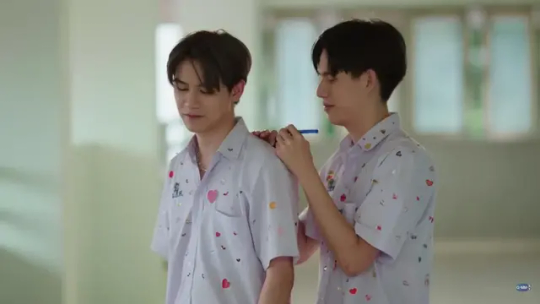
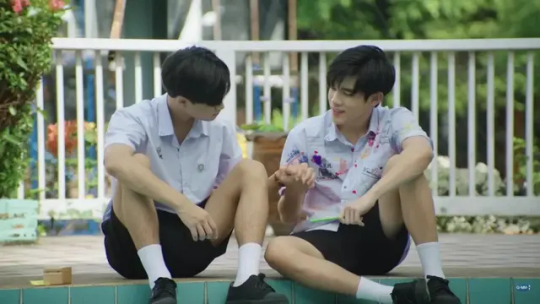



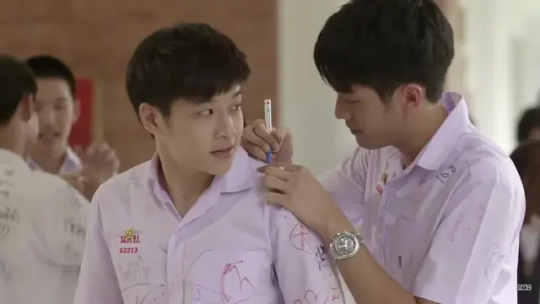

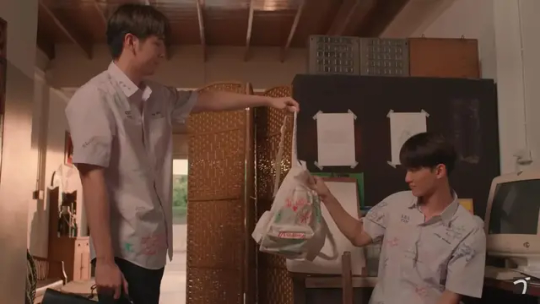









Tomorrow is Friday 14th February, which is the date where the real-life inspiration of these two tropes come to perfectly coincide. Watchers of Thai series will probably have seen them played out, but non-Thai viewers might not realize this is actually two separate real-life traditions in Thai schools.
The heart stickers thing is pretty self-explanatory. Students will give heart stickers and put them on others' shirts on Valentine's Day. It's mainly just for fun, but can also serve as a popularity contest of sorts. Series will lean on this and show popular kids with shirts all covered in hearts, while someone with no hearts at all would be a complete nobody (or a stickler for discipline who refuses to engage in such nonsense, as with Akk in The Eclipse).
The shirt signing, on the other hand, is a tradition associated with the last day of school for graduating students. People will sign just about anything, from silly quotes to sentimental goodbyes. IRL some people will bring a different shirt from the one they're wearing, cause that ink is gonna run off if you put it in the wash, and you won't want a memento that stinks. But series never show this, because there's something special about writing your deepest feelings down against that special person's back, without them immediately discovering what you just said.
What's interesting is that in Thailand, the school year ends in February, so making space for exams afterwards, there's a good chance the last day of school will fall on Valentine's Day. (Well, it's actually 1 in 7 if you have the right week, but you'd also celebrate in advance if the 14th falls on the coming weekend).
And creators love these visuals, either separately or combined for greater effect. For series revolving around high school life, shirt-signing days are especially powerful in evoking the poignancy of saying goodbye, going all the way back to Hormones. The scenes here in My School President, The Best Story, and Nha Harn all play strongly on this. For others, it's used to illustrate the passage of time. And for those who aren't graduating, there's always the sticker-giving opportunity.
(Originally posted here, plus a few additions)
#thai culture#thai bl#plus a few non-bls#thai series#bl meta#my school president#only boo the series#the best story#star in my mind#hormones the series#the miracle of teddy bear#remember me series#my love mix up th#my dear loser: edge of 17#bad buddy#the eclipse the series#my precious the series#a love so beautiful thailand#nha harn the series#That last one has the Frank-New pairing though they're in a different school year
20 notes
·
View notes
Text
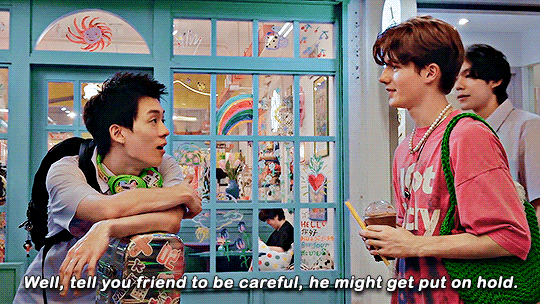
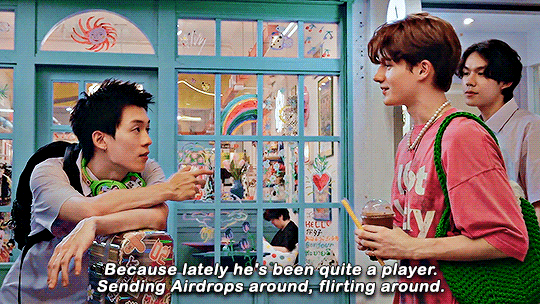
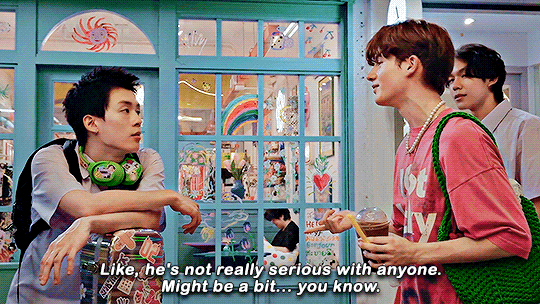
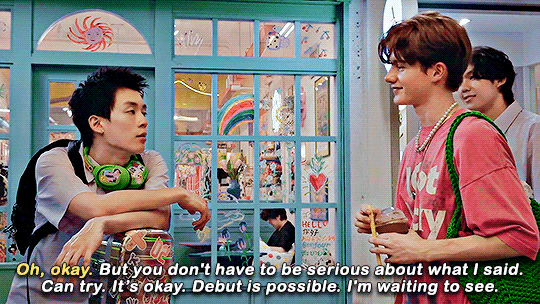
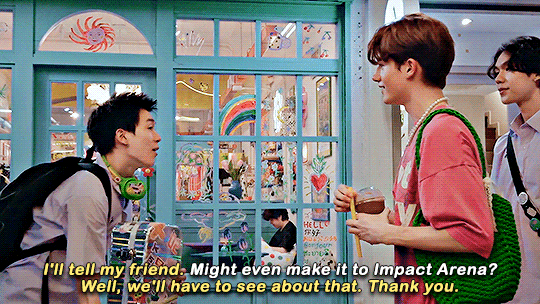
Well, Bua, here's the thing. A friend of mine likes your friend. He thinks there might be potential so he sent me here to talk to you. So... what do you mean when you said "Be prepared"?
GELBOYS สถานะกั๊กใจ — 2025, dir. Boss Kuno & Junior Naron
(detailed translation notes in image description - courtesy of @virtualtadpole)
204 notes
·
View notes
Text
brb. currently screaming at the DETAILS of gelboys ep 1
(SOURCE © @virtualtadpole)



text version under the cut for readers' accessibility
I'll leave the raving about Boss and his team's meticulous craftsmanship to u/ThoughtsAllDay and others, but man, there's so much detail packed in here, I had to take notes. Which wasn't easy while watching on iQiyi without VIP, as each time you inadvertently scroll back past an ad insertion point it forces you to sit through another minute of unskippable ads that just ended five seconds ago. Anyway, some thoughts:
The biggest question I had from the series reveal was whether it's going to be one of those works that could generate endless discussions of "Is this a BL?" And so far it sure looks like one of those works. This first episode is the sliciest a slice-of-life teen drama could conceivably be. Or maybe it just feels that way because it's so different, due to the fact that...
The entire series being shot on iPhone (though they just say "phone" because Apple isn't paying them) gives the whole thing such an indie guerrilla film vibe, which is interesting to say the least. The unrestrained depth of field, the sound design picking up on every little jingling of the charms and chains the boys have on their bags, result in this raw, artsy feel that is almost jarring compared to conventional production values.
The open environment alone sounds like a continuity nightmare, though not having paid much attention to the people and cars in the background, I didn't noticed anything egregious.
The opening toilet shot was... a choice.
The song Fourmod's mother plays in the beginning is เด็กมีปัญหา (Dek Mi Panha) by, of course, Four-Mod. It's one of the biggest early hits from the Kamikaze teen-oriented record label. Faye Fang Kaew is another of the label's first groups. You can tell their mother is a huge fan. (By the way, the iQiyi subtitles spelling Fourmod's name after his Instagram handle is really annoying. Hope they drop it soon.)
Fourmod said "this term" when asking to take the BTS, so it's probably the start of the second semester, i.e. November. Senanikhom Station opened in December 2019, while the entire northern extension opened in December 2020. Either Fourmod was referring to starting his P.6 and M.1 years after the station and line opened respectively, or the series is set in 2023.
I laughed at how they needed a disclaimer warning not to run up the escalators and to hold the handrail - clearly mandated by BTS the series sponsor. If you're wondering about the sponsorship, by the way, it probably just involved them making special arrangements for location access and not any cash - this was the case for the 2009 movie Bangkok Traffic (Love) Story, which revolved almost entirely around the BTS. Here, the lack of crowds during the morning rush hour points to most of the people probably being hired extras.
The BTS got plenty of indirect advertising in exchange, of course. Fourmod buying the monthly pass seemed almost forced at first, but was soon leveraged to explain why he didn't know how to tap out of the system, since he'd presumably only used single tickets before. (Like Thoughts said, the attention to detail is incredible, with things like these that you have to zoom in to even notice.)
The depictions of locations are so super specific to reality, almost as if this were a documentary. The school is fictional, of course, but it's slotted into the exact location of Watpathumwanaram School in real life, and everything around it, including the path of the students' commute, is real. Don't know why they'd take a tuk-tuk instead of walking 400 metres to Siam Square, though, as the traffic is totally impossible.
I have no idea how much creative liberty they're taking with the school's flexibility with body accessories, electronics, and transgender students. I'm sure the creators based it on what's possible at some actual schools nowadays, but I can't tell how realistic it is for the setting at all. Very much appreciate the variability in the lengths of the students' shorts as a reflection of their personality, though, as it's rarely seen on screen anymore.
I raised an eyebrow at Fourmod asking for extra MSG in his fruit dip. (The subtitles mistranslate it as "chili salt".) Didn't even know it was a thing - usually it's just sugar, salt, and chilli - but apparently recipes that also add MSG aren't uncommon.
I'm about curious about the passage of time. Their painted nails almost growing out suggests probably two months passing during each of the time jumps, but that would be almost the entire school term already.
It's funny to imagine how they got Yuedpao as a main sponsor. Their shop is actually opposite Kantima Salon, one wonders whether it's a coincidence or they found the location first, then got the sponsorship later.
The Kluay Kluay banana dessert shop was clearly included to keep older viewers connected - it's probably the only Siam Square location in the entire episode that's recognizable to someone who knew the place from the 2000s. Heck, the neighbourhood has changed so much recently, few of the scene locations would have looked like shown even five years ago.
Which brings me to my final point and main impression from the episode: Everything in it feels so deliberate in its depiction of today's youth culture. Which is of course what the creators set out to do. But the thing is, I (and probably most Millennial and older viewers) can't quite tell how accurate it is. I trust that the team did their research well, and on the whole it feels real enough, but the script's particular references, slang and vernacular might as well be a foreign language. It feels rather eerily uncanny how changed some things have become in the space of a generation, and yet how familiar some things remain.
170 notes
·
View notes
Text
Answers now added!
Think you know older Thai stuff? Well, do you know THESE?
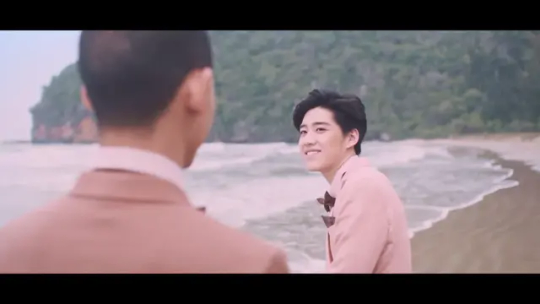
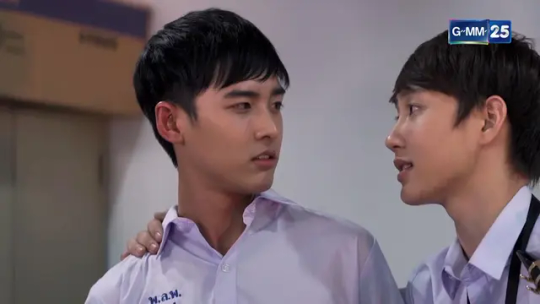
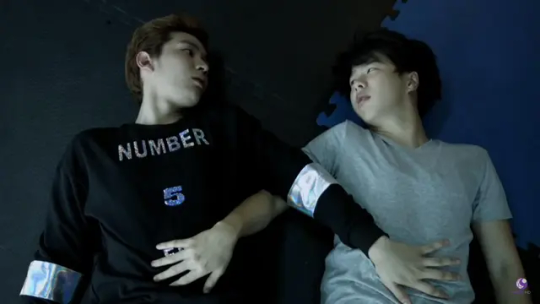
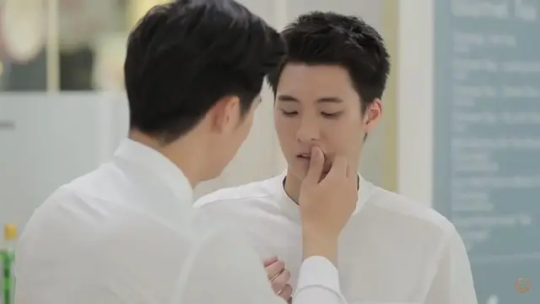
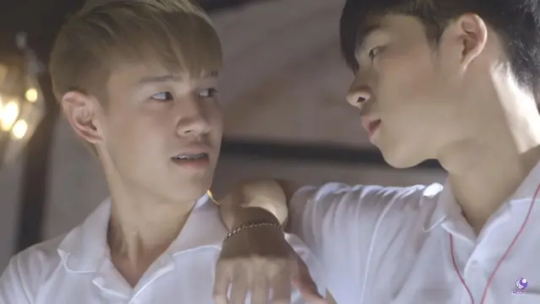

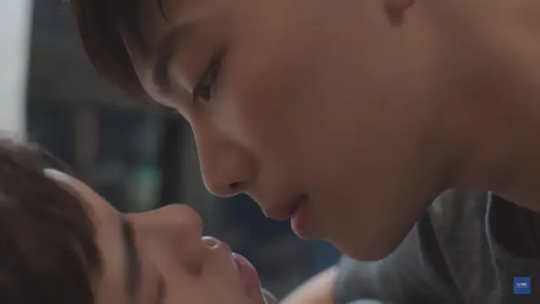
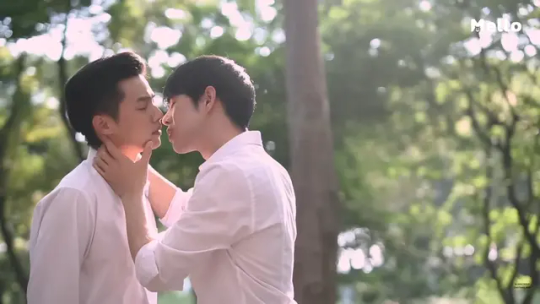
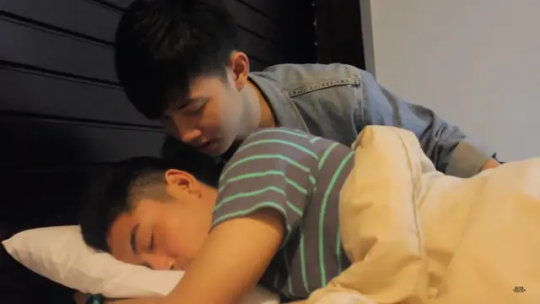
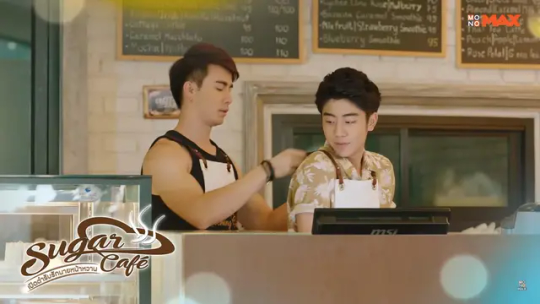
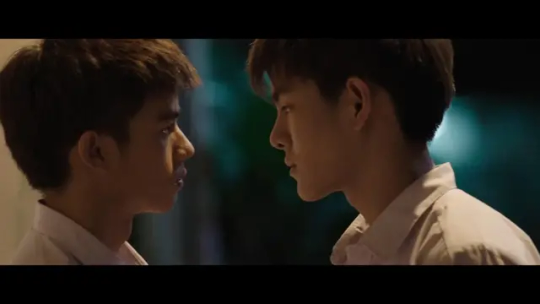
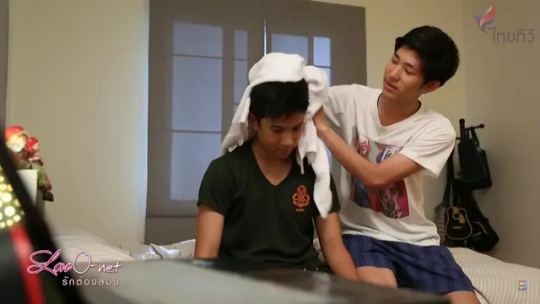
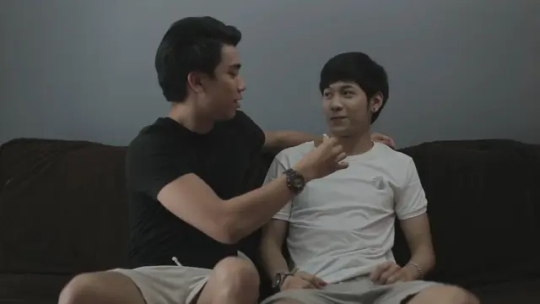
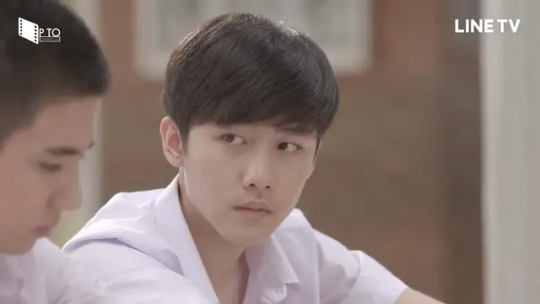
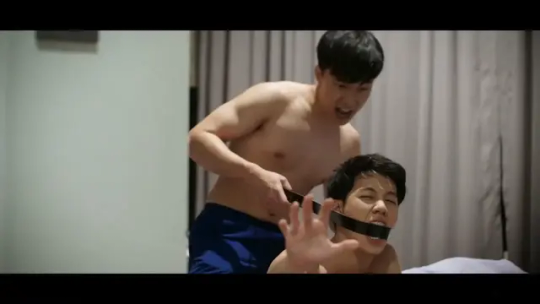
Here's something different for a change. Do you know what series/movies/shorts these are from? Have fun guessing! I'll come back to edit the post with answers in a few days.
Okay, here are the answers!
i Stories: G (2018) - Part of an anthology of LGBT-themed short films sponsored by Honda Motorcycle. PP 's character is part of a group of gay friends who knew each other from being dumped by the same guy.
Love Songs Love Series: Small Boats Should Leave (2017) - A non-BL miniseries with a small side plot where Plustor 's character has a crush on his best friend, played by Captain.
Part Time (2016) - The series has a BL side played by Kimmon and Zo Wongsapat (not in other BLs).
Wun Rak Phon Phak Tang Tua 2 (2016) - Not a BL. This scene from the sitcom has Mean Phiravich and Nut (ntsuntorn, who was in Water Boyy) 's characters doing servicey things for their vlog to gain followers.
The School (2015) - Gameplay and Bombbam Kirati (also seen in What the Duck) play this series' BL side couple.
Love Smart (2015) - A short web miniseries featuring Tommy and Tape Worrachai (The Tuxedo).
The Underwear (2017) - One of the storylines in the series is Got Kanidsorn (Bar in Love Mechanics 2022) 's character secretly crushing on his straight best friend played by Tong Supanut (Lop in Unforgotten Night).
Love Lie Hide Fake (2018) - Job (Miracle of Teddy Bear) and Best Anavil (Till the World Ends) 's characters play a shipped couple acting in a series, though the show's actual BL pairing is Best with Pop Khamgasem.
Memory of Love (2016) - A student short film series featuring Benz Natthapong (EN of Love: This is Love Story) and Mo Weerasak Saenkuntawong (not in other stuff).
Sugar Café (2018) - A straight rom-com movie with Zee and Year Chotritud (who had small parts in The Effect, Our Days) as a tiny BL side pair.
Dangerous Boys (2014) - An action movie with an early BL side couple quite notably kissing on-screen, played by Oat Pasakorn (So Much In Love) and Tong Surawit (Tamtam in That's My Candy).
Love O-net (2014) - one of the early proto-BL TV dramas, featuring Tong Piroonwat (Prince in Fahlanruk) and Speck Phisitphong (Chama in the same series).
Lie (2016) - a student short film featuring Singto and Kanin Smuthkochorn (better known as an ice hockey player).
Please... Siang Riak Winyan (2017) - A horror series and not actually BL at all. Mark Siwat and Perth Tanapon play step brothers.
The Right Man: Because I Love You (2016) - one of three short films sponsored by gay dating app Blued, featuring War and Earthlee Ardivat Leeruangsri (hasn't done other acting work). Each had a certain holiday-associated theme. This one's was mother's day, and it's a cute story about War's character, who's reluctant to come out to his mom. There are a few brief sequences of the boys hooking up and dating, but they don't really show anything particularly naughty (the picture is only seen as a still insert). Sorry for the tease. 😆
45 notes
·
View notes
Text
Think you know older Thai stuff? Well, do you know THESE?















Here's something different for a change. Do you know what series/movies/shorts these are from? Have fun guessing! I'll come back to edit the post with answers in a few days.
Okay, here are the answers!
i Stories: G (2018) - Part of an anthology of LGBT-themed short films sponsored by Honda Motorcycle. PP 's character is part of a group of gay friends who knew each other from being dumped by the same guy.
Love Songs Love Series: Small Boats Should Leave (2017) - A non-BL miniseries with a small side plot where Plustor 's character has a crush on his best friend, played by Captain.
Part Time (2016) - The series has a BL side played by Kimmon and Zo Wongsapat (not in other BLs).
Wun Rak Phon Phak Tang Tua 2 (2016) - Not a BL. This scene from the sitcom has Mean Phiravich and Nut (ntsuntorn, who was in Water Boyy) 's characters doing servicey things for their vlog to gain followers.
The School (2015) - Gameplay and Bombbam Kirati (also seen in What the Duck) play this series' BL side couple.
Love Smart (2015) - A short web miniseries featuring Tommy and Tape Worrachai (The Tuxedo).
The Underwear (2017) - One of the storylines in the series is Got Kanidsorn (Bar in Love Mechanics 2022) 's character secretly crushing on his straight best friend played by Tong Supanut (Lop in Unforgotten Night).
Love Lie Hide Fake (2018) - Job (Miracle of Teddy Bear) and Best Anavil (Till the World Ends) 's characters play a shipped couple acting in a series, though the show's actual BL pairing is Best with Pop Khamgasem.
Memory of Love (2016) - A student short film series featuring Benz Natthapong (EN of Love: This is Love Story) and Mo Weerasak Saenkuntawong (not in other stuff).
Sugar Café (2018) - A straight rom-com movie with Zee and Year Chotritud (who had small parts in The Effect, Our Days) as a tiny BL side pair.
Dangerous Boys (2014) - An action movie with an early BL side couple quite notably kissing on-screen, played by Oat Pasakorn (So Much In Love) and Tong Surawit (Tamtam in That's My Candy).
Love O-net (2014) - one of the early proto-BL TV dramas, featuring Tong Piroonwat (Prince in Fahlanruk) and Speck Phisitphong (Chama in the same series).
Lie (2016) - a student short film featuring Singto and Kanin Smuthkochorn (better known as an ice hockey player).
Please... Siang Riak Winyan (2017) - A horror series and not actually BL at all. Mark Siwat and Perth Tanapon play step brothers.
The Right Man: Because I Love You (2016) - one of three short films sponsored by gay dating app Blued, featuring War and Earthlee Ardivat Leeruangsri (hasn't done other acting work). Each had a certain holiday-associated theme. This one's was mother's day, and it's a cute story about War's character, who's reluctant to come out to his mom. There are a few brief sequences of the boys hooking up and dating, but they don't really show anything particularly naughty (the picture is only seen as a still insert). Sorry for the tease. 😆
#thai bl#bl history#pp krit#plustor pronpiphat#captain chonlathorn#kimmon warodom#mean phiravich#gameplay garnpaphon#tommy sittichok#tape worrachai#got kanidsorn#tong supanut#job thuchapon#best anavil#benz natthapong#zee pruk#year chotritud#oat pasakorn#tong surawit#singto prachaya#mark siwat#perth tanapon#war wanarat
45 notes
·
View notes
Text
Thailand's "cute boy" craze: an explainer
Here's another repost from Reddit, originally from 2022. Since Perfect 10 Liners is currently airing with the "cute boy" page as a key plot point, this seems as good a time as any to re-share (remember that the original novel was first released in 2018). Sorry this one is a wall of text, I wasn't sure it'd be a good idea to include example photos involving people who weren't really public figures at the time.
Those of you following Thai BL will probably have come across this concept of "cute boy" social media fan pages, and might have wondered whether they're an actual thing. Or you may have heard of actors being one of their university's cute boys before joining the industry, and wondered what exactly that meant. Here's my attempt at an explanation.
The roots of the phenomenon go back at least to the popular Thai web forums of the 2000s, especially the youth-oriented Dek-D.com, one of Thailand's biggest and oldest web communities (also known as the web fiction platform which launched many BL novels). Dek-D's forums had a picture-sharing section, with a subsection dedicated to photos of cute guys and girls. It was still the early days of digital cameras and camera phones, and these posts were popular among the site's teen users. A few (mostly girls) who became noticed from these posts became Thailand's first "net idols", many of whom went on to join the entertainment industry.
The arrival of social networking sites around 2007 (first Hi5, then Facebook a few years later) helped facilitate these posts, as publicly posted photos became more easily accessible. The issue of privacy wasn't really on most people's minds then, and most of it was done in a light-hearted spirit. Being featured in these posts meant a boost in followers and online popularity, enabling more teens to become recognized as net idols, but it would be a few more years before this really meant anything. On the other hand, the social networking sites themselves would eventually bypass the traditional forums as a central venue for such posts, and an increasing number of Facebook pages (followed by dedicated Instagram and Twitter accounts) would be created to offer a curated experience instead.
The actual trend of "cute boy" pages took off in 2012, around the same time as the explosive growth of Instagram. Teens flocking to the platform (escaping Facebook, which was now full of parents) filled their public profiles with selfies and portraits of themselves, generating a steady stream of material that these pages could pick up to post and promote. This in turn gave the kids likes and followers, a mutually beneficial arrangement for most thanks to the platform's like-seeking culture.
Of course, not all of these proliferating pages featured teen boys. "Cute girl" pages have their share of followers, though they don't seem to be as visible or talked about, perhaps due to a combination of factors including the way society doesn't consider it as creepy for girls to openly ogle after boys compared to the opposite.
As competition grew, these pages diversified into several niches, including those covering specific schools and universities. Most of the school ones aren't that unusual, given that it's quite natural for students to talk about the popular boys and girls at school, and this had been a trend in school forums long before then. Most of them didn't last long though, as page administrators soon graduated and moved on.
However, things were different for certain high-profile schools, particularly the country's four oldest boys' schools, which participate in the biennial Jaturamitr football competition: Suankularb (SK), Debsirin (DS), Assumption (AC) and Bangkok Christian (BCC). The schools had always been well known, but the Instagram era launched an unprecedented wave of interest in their good-looking students, many of whom attracted huge numbers of followers just by being on Instagram. AC especially stands out in this regard, as Instagram allowed outsiders to glimpse into this exclusive boys' world that served as the basis of Love Sick, the source novel of which was begun in 2008.
Not only were cute boy pages created dedicated to these schools (some by outsiders), some of the boys became minor celebrities in their own right, with fans (mostly sao Y (the Thai term for fujoshi), and also some queer folk) meeting up with and photographing them in real life, especially at school events such as AC's Christmas fair and the Jaturamitr competition. And they were serious about it, coming equipped with professional DLSR cameras and huge telephoto lenses. The schools' student bodies leaned into this popularity, having the popular boys promote fundraising events and selling merchandise to their fans.
The relationship between the boys and their fans seemed to be mostly good, the boys appreciating the positive attention and the fans getting to stan someone much more accessible than the mainstream celebrity. And if they later became famous, then there's the pride of having known them before everyone else. These being sao Y, there sometimes is a bit of shipping, though mostly jokingly. Of course, this was not limited to boys from AC and the other Jaturamitr schools, but they were much more prominent.
This was the backdrop against which Love Sick launched its casting calls in 2014, which generated a huge amount of online buzz throughout the cute boy pages and fan Twitter. There's a reason the series featured such a huge cast with so many minor roles - to provide ample opportunity for fans to latch onto the actors and the show.
In some ways, the cute boy label served as a distancing from the previous term net idol, which by 2014 had begun to develop into a negative stereotype of people using their online fame to sell beauty products for easy profit, especially those livestreaming on emerging platforms such as Socialcam and Bigo Live and whose followers tended to be less sophisticated as opposed to the urban middle-class. Which is why most people appearing on cute boy pages tended to come from higher socioeconomic backgrounds, and much more attention was given to those focusing on elite schools and universities.
At the university level, cute boy (or other similarly named) pages associated with the country's top universities became very prominent online and also offline, often collaborating with the universities' student bodies to promote events and sometimes also assisting in the universities' PR for prospective students. Many universities already had a pageant culture in one form or another, with which these pages tied in well. Most prominent among the pages were Chula Cute Boy and TU Sexy Boy of Chulalongkorn and Thammasat, the country's two oldest universities. The two universities have an annual traditional football match, which the Cute Boy and Sexy Boy pages played large parts promoting in recent years, and is another event that attracts many fangirls.
Some have argued that the net idol phenomenon serves as a democratization of the entertainment industry, opening up opportunities for aspirants to directly connect to audiences as opposed to the traditional model where everything depended on one being picked up by an agency. But it benefits the traditional model as well. While in the old days talent scouts would look for teens hanging out at Siam Square, today they only have to scan the cute boy pages. Many BL actors were discovered this way. Inn Sarin was a long-time favourite of Chula Cute Boy, and Up and Mix first became widely known from there as well. Many others have likewise previously been featured in various cute boy pages, and practically all of the younger actors who joined the industry more recently probably had strong followings before their debut.
But the craze might be coming to an end. While there have long been concerns over today's youth's obsession with looks, and the university cute boy pages have from the beginning been criticized for promoting shallow images of their universities at the expense of academic aspects, they didn't really have any effect on the trend. But this began to change in 2020, when a widespread youth protest movement swept through school and university campuses and liberal progressive ideas rose to the fore. The issue of "beauty privilege" became one of many perpetual topics of discussion, and many began calling for an end to university cute boy pages. Thammasat, long regarded as the university with the strongest student activism, saw the TU Sexy Boy page shutting down (though the admin cited personal reasons and it was never confirmed whether this was in response to the criticism). Many people seem to have stopped tweeting cute boy pictures since then.
On top of the political mood, the pandemic's disruption of normal school life also interrupted the cute boy momentum, as many photo opportunities dried up. Long-time page admins and fans outgrowing the topic and losing interest might also be a factor. The Chula Cute Boy page has also been inactive since late 2020, for undisclosed reasons.
The future seems at best unclear for now. There are still many active pages out there, but on the whole, from what I've seen, there does seem to be a loss of interest. If younger netizens are indeed disinclined to craze after them the same way, the era of cute boy pages might very well soon be over.
Or maybe they've just moved onto TikTok, and I haven't found out how.
----
In the above original post, I neglected to go into the phenomenon of real-people shipping, so I'm attaching this comment from later as an addendum:
Regarding real-people shipping, there are probably two lines of origin that influenced the practice. First is the rise of K-pop and the shipping culture that came with it, which led to a proliferation of online fanfiction in dedicated Thai web communities and a shipping culture forming around the reality singing competitions which were the talk-of-the-town entertainment programs in the 2000s. One of the first really famous shipped pairs was Nat and Tol from Academy Fantasia season 4 in 2007. (That is Nat Sakdatorn, whom you may recognize as the uncle from Never Let Me Go, among many other roles.)
The other origin is the rise of "net idols", which followed the arrival of social media sites (in Thailand this was led by Hi5 in 2006). I covered this in more detail in my post on Thailand's "cute boy" craze, but didn't really touch upon the shipping aspect. Indeed, a significant shipping culture did form (a few years later) around net idols/cute boys. At first this focused more on (people who were believed to be) real-life couples, like Both and Newyear, who became famous in 2012. From there, manufactured/imaginary couples naturally followed in hopes of cashing in on the popularity of such shipped pairs.
I'm a bit hazy on when the shipping of actors as couples actually became a regular thing in the BL industry. While the practice of fanservice moments on the promotion circuit go back at least to The Love of Siam, I don't think there was significant shipping of the actors' real-life persona, and the same seemed to be the case with Love Sick, especially after the series ended. The first actor pair to become shipped as such was probably Krist and Singto from SOTUS, and the practice quite definitely became a thing after that.
----
Postscript: Thanks for reading, and sorry the writing in this one isn't as good as the other posts I've shared. If you're interested in further reading on the topic, I can recommend the article The Yaoi Phenomenon in Thailand and Fan/Industry Interaction. (2019). Plaridel, 16(2), 63–89 by Assoc. Prof. Natthanai Prasannam, one of the leading Thai academics on BL/Y culture in Thailand.
97 notes
·
View notes
Text
A BL viewer's guide to Thai school uniforms
(This is an older one, originally posted at Reddit in 2022, but it should still be accurate. Hope you'll find it useful, as uniforms in Thai shows often provide context that international viewers might not recognize.)
To begin, here's a summary of the Thai school system. There are twelve years of basic education (after kindergarten): six years of primary school (prathom or P.1-6), and six years of secondary school (mathayom or M.1-6), the latter of which is divided into three lower and three upper years. The age range roughly corresponds to the US system, so the years P.1-6 will often be translated as grades 1-6 and M.1-6 as grades 7-12. Most stories set in school will take place during the upper secondary years, which is often translated as high school (though this is rather approximate as it spans three years rather than four). Students typically enter M.4 aged 15 going on 16, and graduate at the age of 18 (or nearing it).
School uniforms are almost universally compulsory, used by all but a few alternative schools (university will be discussed further below). They mostly follow a very distinctive form, which has barely changed since the end of World War II, as there's a default format that's mandated by law and followed by most schools (though schools may elect to specify their own style of uniform). There are official industrial standards that govern the material, thread count, etc. of student uniforms that can be sold, and an entire industry is built around them.
For boys, the (default style) uniform is mostly the same across all levels, and consists of a white short-sleeved button-up shirt, shorts (in either black, royal blue, navy, or khaki), a belt (brown or black), socks and shoes (brown with khaki shorts, white socks and black shoes otherwise). The shirt will have the letters of the school's abbreviated name embroidered at the right chest, in red for private schools, and navy for government schools. It's common for schools to also require student IDs or names be included likewise. In many schools, the upper-secondary uniform will also include the school insignia/logo as a metal badge pinned above the school's initials, or also embroidered.
The colours of the shorts typically reflect the school's status. Private schools will normally use blue or (less often) black, while government schools will use black or (less often) khaki, with very few exceptions. Navy is quite rare, mostly used by certain schools with historical royal connections. This colour-coding serves as a rather convenient tool for series creators to convey the social background of the characters. Blue shorts signify that they go to a private, presumably expensive school. Black is the default that tells the viewer that it's a regular, average school. Khaki shorts used to be the default long ago but have declined in use, and are now mostly seen as belonging to rural or temple schools (though there are also some famous schools that use them). You'll rarely see them in TV or film, unless the creators are purposely saying that the setting is rural, poor, or retro.
Let's look at some examples.

The school uniform in Bad Buddy is pretty much the bare minimum, with just the school's abbreviated name and no pin or ID. With black shorts and navy lettering, it's clearly meant to be a regular government school (though TBH the filming location doesn't really fit). The dot on the collar is a symbol used by some schools to indicate the year the student is in, based on the number of dots. One dot would mean they're in the first year of either lower or upper secondary, which might be differentiated based on colour, shape, or being on the left or right side. Here, Pran is clearly not 12/13 years old, so the year must be M.4.

In The Yearbook, the school uniform also includes the students' ID in Thai numerals below the school name, also quite a common thing. The navy lettering and the black shorts indicate that it's a government school, and the filming location and the teacher wearing the civil service uniform also hint that it's a rather provincial setting. The haircuts of the characters are also more realistic, as schools usually require a short tapered cut for boys.
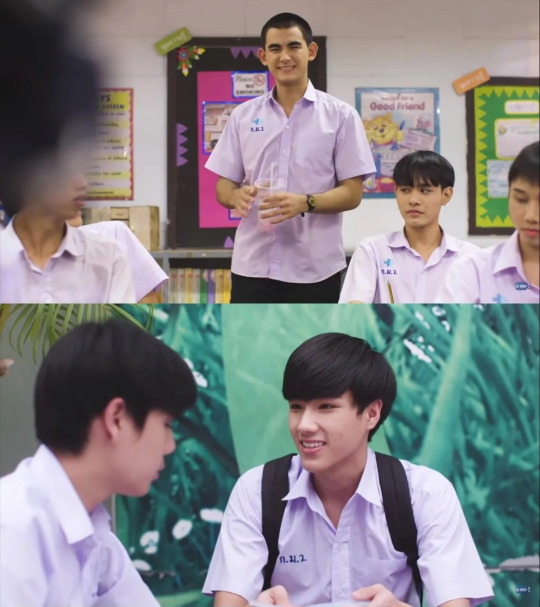
The characters in 'Cause You're My Boy also attend a government school, in line with the working-class background. Mork is in upper-secondary, so his uniform as the school symbol embroidered above the lettering, while Gord and Morn's, who are in lower-secondary, don't.
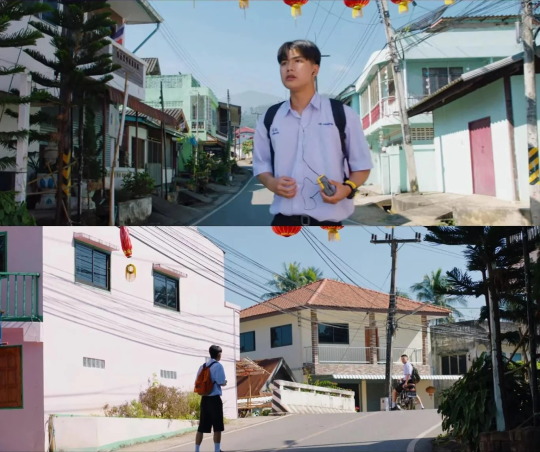
Another example of a government school uniform with black shorts is found in Dew. This school also has the student's name embroidered over the shirt pocket. Dew's oversized shirt and long baggy shorts reflect the fashion trends of 1996, when this part of the story is set.

On the other hand, Hormones follows middle-/upper-middle- class kids at a private school. The uniform was directly copied from that of Assumption College Thonburi (ACT), where the series was filmed (so that its students could blend in as extras). As a private school, the lettering is in red, and the student IDs are in Hindu-Arabic numerals. As in the above example, the stars on the collar indicate the student's year (here, dots are used for lower-secondary and stars for upper). Also note the belt buckle with the school logo, which tends to be seen with fancier schools.
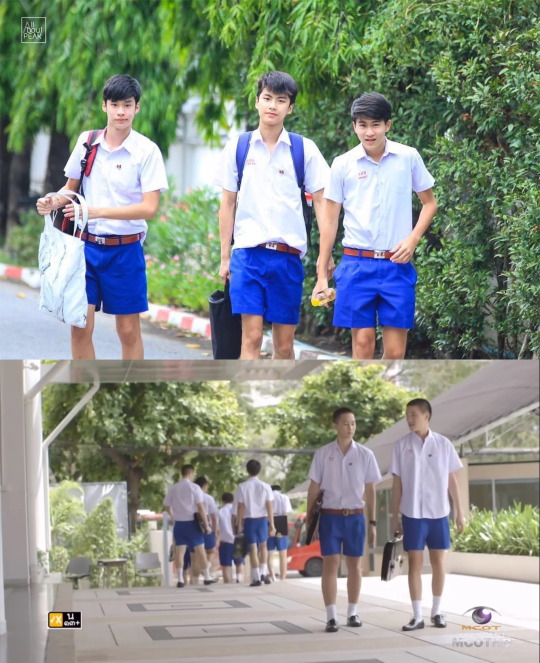
The uniforms in Love Sick are also copied from real life, though this was done not for production convenience, but to pay tribute to the source novel, which was inspired by student life at Assumption College (AC), one of the country's oldest boys' schools (AC and ACT both belong to a network of schools operated by the Catholic Church, hence their names). The novel's full title, Love Sick: The Chaotic Lives of Blue Shorts Guys, reflects its focus on the inside world of the school, of which it paints a semi-imaginary image that makes multiple references to actual teachers, locations and customs, stopping short only of referring to the school by name. This is toned down in the series, though the coat of arms and uniform are nearly direct copies of AC's, minus the belt buckle (which was a relatively recent addition and not part of the uniform when the novel was being written).
Notice how Noh's school badge is pinned on the corner of the shirt pocket just like baby Peak and Ohm's real-life AC uniform, which is unique to the school. (Beam is a junior of Peak and Ohm's by a year, and was probably in M.3 when the photo was taken, so didn't wear a badge.) The school also requires leather shoes, unlike most schools which allow either leather or canvas shoes (in which case almost everyone will wear canvas shoes).
As mentioned in my previous post, the current trend of students having their school uniform shorts modified to be very short probably originated with AC students, and spread more widely from the late 2000s. Naturally, the style is shown in Love Sick, though this is also generally well represented in BL media.

Make It Right, by the creators of Love Sick, used the same style for its student uniform, except the shoes (though pinning the badge at the shirt pocket didn't really make sense now that it wasn't meant to refer AC's real-life uniqueness). It's also a bit strange seeing student IDs running into the 60000s, as even the oldest real-life schools don't have numbers that high.
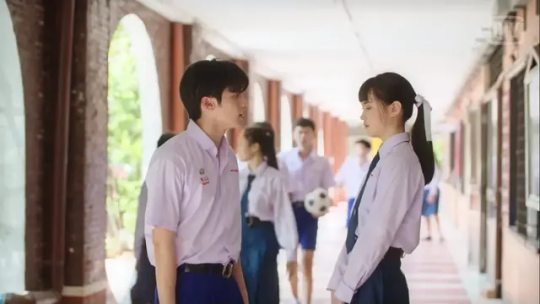
The use of blue-shorts school uniforms to signify wealthy characters/environments is a pretty common trope in BL (and also Thai series more generally). It's also seen in 7 Project, in a more typical appearance with the pin in the usual location, and the student's name over the shirt pocket.
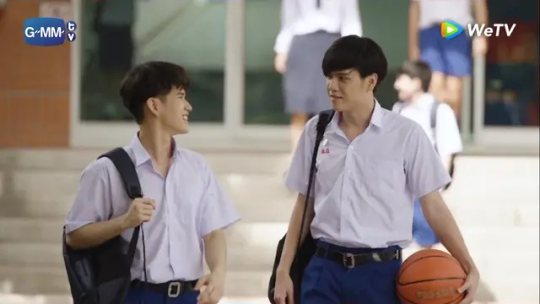
In My Gear and Your Gown, the uniform (quite unusually for private schools) doesn't have any lettering other than the school's initials. It's most likely a cost-saving measure by the costume department, sacrificing a bit of realism to avoid the need to create individualized outfits for every character (though it does use leather shoes).
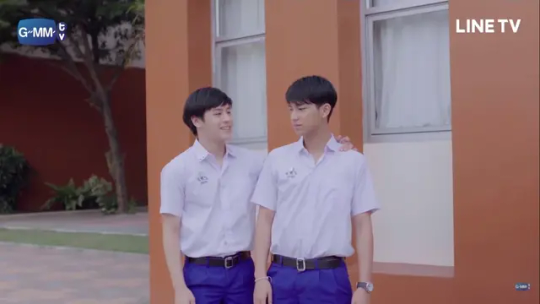
The uniform in My Dear Loser: Edge of 17 is rather confusing. It's clearly meant to be a private school, given the blue shorts, but this is contradicted by the navy lettering on the shirt. Looks like a mistake, unless it was a deliberate choice to introduce some sort of ambiguity (though this is unlikely, and even most Thai viewers probably won't notice anyway).
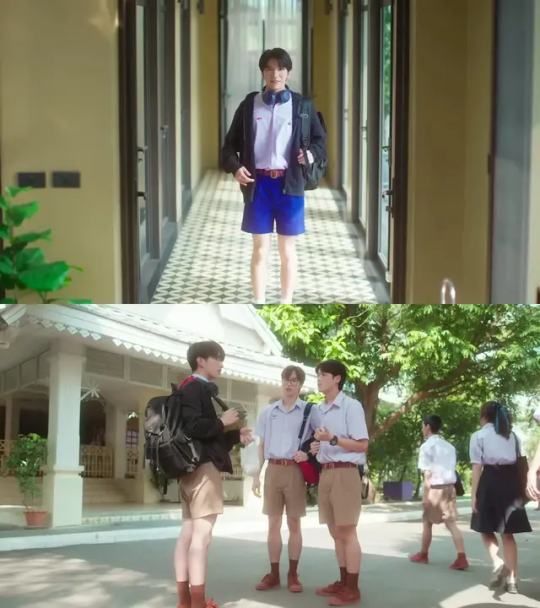
In Only Boo!, Moo originally goes to a private school with a blue-shorts uniform, but is sent away as punishment for neglecting his studies. His new uniform, with khaki shorts, emphasizes the provincial nature of the school.

Often, different-coloured uniforms will be used to contrast the characters' backgrounds. This goes back to The Love of Siam, where the blue shorts and leather shoes of Mew's school uniform reinforce its presentation as a Catholic school (and closely echoes AC, which also served as the school's filming location), while Tong's black-shorts uniform may have been a reference to Bangkok Christian College, a nearby school popularly seen as a rival of AC's. BCC is one of the better known private schools to use a uniform with black shorts, and The Love of Siam is one of the less common examples of this. (Note again the school badge, which isn't worn by some of the members of Mew's band, indicating that they're in lower-secondary.)

The colour contrast is also used in Love's Coming, though it doesn't really convey any significant background.
Somewhat amusingly, creators don't always try to be particularly creative with the school name abbreviations, and they will often be that of the production company's name. So here we have ม.ม. and ม.ม.ป. - MM and MMP for Mungmee Production. Above, there's จ.ท.ว. - GTV (GMMTV) in My Dear Loser, ค.ซ.ม. - CSM (Cosocomo) in Make It Right, and น.ด.บ. - NDB (Nadao Bangkok) for Hormones, the last of which is also the actual in-story name of the school.

I Told Sunset About You uses a very unusual colour pairing: Navy and Khaki. Oh-aew's school (and Teh's formerly) is private, while Teh's is the province's main government school. The colour choices are mainly aesthetic - while some main provincial schools do use khaki shorts (and private schools navy), they are quite uncommon. White shoes worn with the regular student uniform is also practically unheard of (they're usually for PE uniforms - more on these below).
Note also how the year-indicating dots above the school initials are differentiated by colour: navy for lower secondary, red for upper. So when Teh shows up at his old school wearing a uniform with three navy dots, that's him squeezing into his old uniform from M.3 to sneak into the school.

Sometimes actual existing schools serve as the setting of a work, and its uniform is used. For example, My Bromance (2014) is set at Wachirawit School in Chiang Mai and uses its uniform.

The Best Story likewise takes place at the Demonstration School of Suan Sunandha Rajabhat University. Demonstration or "Satit" schools are pretty much a class of their own. While they're technically government schools, they're operated by universities for their teacher training programmes, and have a higher degree of freedom in their operations. They also often have uniforms that don't follow the usual format, with no school name on the shirt. This is the case with Satit Suansunandha, which has its logo embroidered on the shirt pocket and pinned above the student's name instead.
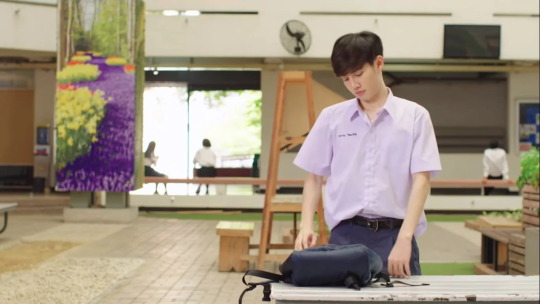
Some Satit schools also use an unusual colour, charcoal grey, for their uniform shorts. This is seen with Praram's uniform in EN of Love: This Is Love Story, indicating that his school is attached to the university. Having just the student's name and no school initials isn't unusual in this case (though not having any logo at all kind of is).

On the other hand, the lack of any embroidered lettering at all, like in The Shipper, is very unusual. In real life this is unique to Triam Udom Suksa School, which is commonly regarded as the country's top school. GMMTV previously did this in The Gifted, which kind of made sense as it conveyed that the school was unique and special, but this isn't true for The Shipper, so the stylistic choice seems a bit lazy.
This is also the case with 55:15 Never Too Late. Even stranger is the uniform from Nanon's storyline, which has khaki shorts signifying a provincial setting but the top is just a plain shirt with no markings or pin at all. It looks rather like an error in the production process that they had to roll with due to some limitation.

Girls' uniforms are much more varied, as private schools follow a variety of different styles. The standard style is mostly only used by government schools. For the upper-secondary level, it's a white button-up shirt (or blouse? I'm not sure of the terminology) with short sleeves that are pleated at the cuff, a navy (or, uncommonly, black) skirt with three pairs of wide pleats at the front and back, a black belt, white socks and black strapped shoes. The shirt will have the same markings as the boys' uniform. We see Pa wearing this in Bad Buddy (and also Tarn in the ITSAY pic above). Note that they made a mistake with her collar dot, as she was in M.6 in this scene and should have had three dots instead of one. (The same mistake happens with the younger music club students in episode 10. I guess the costume department just created one style based on the main characters and forgot to factor in the others.)
I won't attempt to list examples of all girls' uniforms here, as they're harder to keep track of in BL, but if it's a high-school setting and you see a different style of uniform than the above, it should be quite safe to assume it's a private school (especially if it's long-sleeved, with a necktie, or a blue, red or other brightly coloured skirt, like in the 7 Project example above), or a Satit school.

International schools usually have a different style of uniform altogether. They may be variably coloured, use shorts or trousers, include neckties, and the shirts won't have the usual lettering but commonly feature the school logo. Girls' skirts will commonly have a plaid/tartan pattern. Bilingual schools - private schools featuring a bilingual curriculum, with mainly Thai students - will also often use this style of uniform to some extent. We see it in Brothers, where the setting is supposed to be an international school.
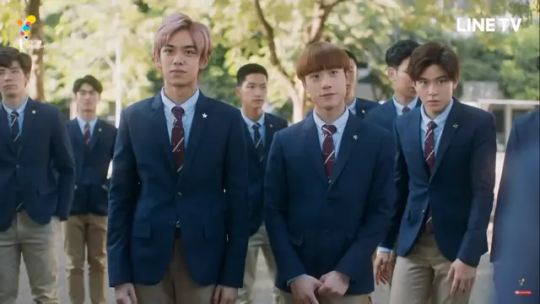
While schools may have a full uniform with blazers and all, they'd only be used on special occasions. If characters wear them on a regular basis, it probably signifies a fantasy setting, or one somewhat removed from real life. This is fully utilized in Great Men Academy, which is as fantasy as you can get with magical wish-granting unicorns.

A similar effect is achieved with sweater vests, as seen in Second Chance. However, this is to emulate the Japanese/Korean uniform style, giving the show something of a J-/K-drama aesthetic while moving it away from the grounded reality of Thailand.
Sometimes, as in Friend Forever, a novel style is created that doesn't really carry any inherent meaning but is presumably done mainly for aesthetic reasons.
In real life, the standard-style boys' uniform (with embroidered lettering) may also use trousers, but this is only done in Islamic schools and the vocational education system, which are pretty much outside the realm of BL stories, so you won't likely come across them. (Update: This is no longer true with the existence of Don't Touch My Gang, but it didn't feature regular uniform, only the workshop shirt, which is covered below.)

Apart from the standard school uniform, most schools will also have a PE uniform, used on days with PE (gym) class, typically once a week for upper-secondary students. These aren't legally regulated, so they come in a large variety of styles, though many government schools will follow the same basic style of a coloured polo shirt made with a woven fabric, usually with the school logo on the pocket. We see Teh wearing this (though with the school initials instead of a logo) in ITSAY, with his usual uniform shorts. Most schools will have students wear the PE top from home and change into the PE bottom (typically sweatpants) just for PE class. Don't expect to see school showers, though, as they're not done in Thailand. Different classes mostly have PE on different days, and in meticulously written shows like ITSAY, where everything fits into the calendar, you can tell the day of the week from the PE uniform (it's Monday if you see Teh in his blue PE top).
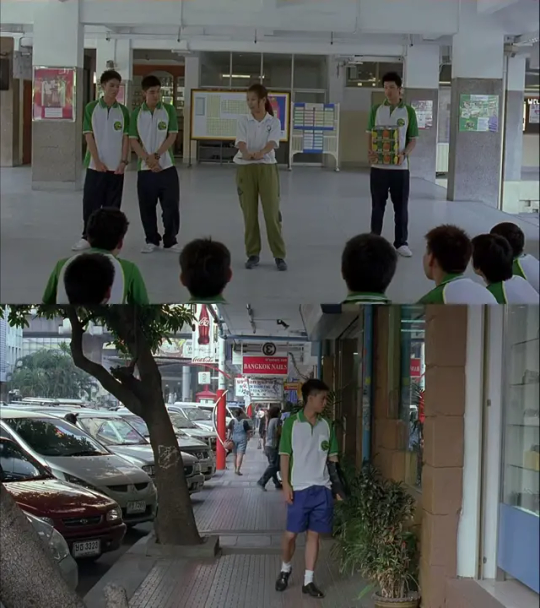
As mentioned above, white canvas shoes may be required for PE uniforms, as seen again in The Love of Siam. This is mostly a feature of girls' uniforms, though, as boys' uniforms will more often use the shoes that are already part of their regular uniform, but schools which normally use leather shoes are a natural exception. However, they will more typically have students wear white shoes from home together with the PE top rather than change shoes at school like Mew apparently does. The shirt style here, a custom-patterned polo shirt with a knitted fabric, is also common.
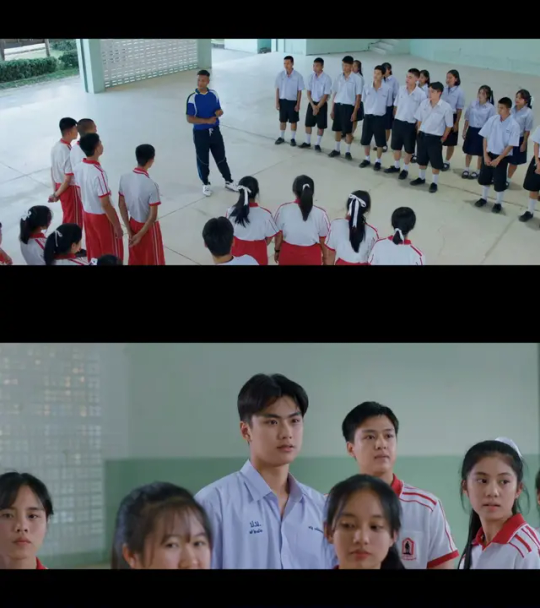
We see another example of the style in Dew. Except for shoe colour, PE uniforms are usually identical for boys and girls.
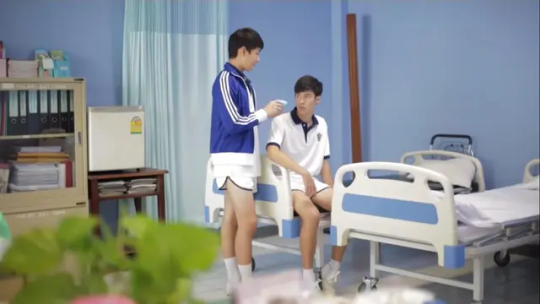
Since there aren't actual limitations to PE uniform designs even in real life, creators sometimes have a field day with them. In Make It Right, the PE uniform is quite obviously a piece of fan service. (There are real-life schools that do use shorts, though they're not quite that short.)

Another uniform you might encounter is the Territorial Defence Student uniform. In Thailand, men face military conscription at age 21, upon which they will have to draw a lottery to determine whether they must enlist for two years. But there's an alternative to that. By completing three years of military training as Territorial Defence Students (often referred to as ร.ด. - Ror Dor (R.D.)), which is offered to upper-secondary school students, one avoids the need to face the lottery completely. Naturally, most middle-class boys will take the training. It takes half a day a week for 20 weeks each year (which is half the school year), plus up to a week of field training around January-February. For the weekly training days, if the session is in the afternoon, school will typically have only morning classes.
The need to attend Ror Dor is probably the most universally hated aspect of high school life for Thai boys, not because of the training itself, which is hardly intensive at all, but because of the military haircut requirements. Naturally this is never portrayed realistically, and many works ignore the existence of Ror Dor altogether. What's kind of funny is that the above storyline concerns Tee needing a haircut to pass Ror Dor inspection, but none of the characters except Mork come anywhere close.
The Ror Dor uniform is a khaki green combat uniform, with the student's name on the right chest and the school patch on the right arm. The Thai numeral on the left collar indicates the student's year. Here, it's ๒ (2), indicating that they're in the second year of training, which means M.5. The green T-shirt worn underneath is often worn casually by some.

In stories that go down to the lower-secondary or primary years, you may also see the Boy Scout uniform. In most schools, participation is mandatory for students up to M.3, and takes place once a week. Here in The Love of Siam, we see young Tong in the Scout uniform, indicating that he's in primary school, while Eiw and Cake in My Only 12% are wearing the Senior Scout uniform (with the maroon shoulder boards) of lower-secondary students.
That's pretty much everything regarding school uniforms, I think. Onto university...
In Thailand, universities have uniforms for undergraduate students. Unlike school uniforms, which are very specific, university uniforms are more loosely defined. In most cases they will be a white dress shirt and black (or navy) slacks for males, with black dress shoes, and a necktie and a belt buckle bearing the university symbol. For females, it's usually a white shirt/blouse with the university symbol pin, a black (or navy) skirt, shoes, and also a belt buckle bearing the university symbol. Some universities will also have metal buttons with the university symbol that have to be attached to the shirt.
While most universities will have defined uniforms, in practice, the requirements vary across universities (and across faculties within the same university). Many require that uniforms be worn for attendance of all classes, but some don't, and expect them only on exam days or special occasions. Strictness and adherence also varies. Often, people won't bother with the belt buckle, sneakers may be allowed (or turned a blind eye to), and jeans may even be permissible. This gives creators more leeway in designing the costumes to a varied visual effect.

In the above scene from Bad Buddy, Pran's upright collar (GMMTV does seem to like these, though I don't quite recall seeing them in real life), Wai's short sleeves (some universities officially have them as a uniform option, some don't), Safe's jacket (which is totally normal, by the way - they do blast the aircon in some lecture halls) and Louis's workshop shirt (more on this below) combine to provide visual contrast. The costume design is also often used for characterization. In Love by Chance, the timid and deferential Pete always wears his necktie, while the brasher Ae is never seen with it, nor does his shirt ever seem to be tucked in. (Untucked shirts are also used for characterization with school uniforms, though it's pretty much the only option.)

Even where uniforms are more strictly enforced, the necktie is usually not worn outside of formal occasions. Some universities have a tradition of requiring them only for freshmen, and similarly female freshmen may be required to wear below-knee accordion-pleated skirts (and for some universities, white shoes) for the entire first year. All of this is shown in SOTUS, as the entire series revolves around these hazing traditions. As freshmen, M and May wear the full university uniform (May with pleated skirt), while the sophomores are seen wearing pencil/mini-skirts and jeans with no necktie. The necktie doesn't have a printed logo, though it's attached as a tie pin - some schools do this. (Quite a lot of series, however, don't bother with having any sort of logo on the tie or belt buckle at all, which is a bit unrealistic, but in some cases could be explained away by the above-mentioned variability in strictness.)
Also famously depicted in SOTUS is the workshop shirt/smock/overshirt, which isn't really an official uniform, but a protective garment meant for practical classes. In some schools, there's been considerable drama over their use, as students often use it as a cover for casual clothing instead of wearing the regular uniform, which the staff disapproves. As so many series show, it's indeed quite commonly seen as an engineering-school symbol.
And that's pretty much all I can think of. If you've made it this far, thanks and congratulations! :p Let me know if I've forgotten anything.
274 notes
·
View notes
Text
Behind the blue shorts: How an all-boys Catholic school sparked the origination of Thai BL
(Cross-post from Reddit)
One evening this past July in Bangkok's long-time youth hangout of Siam Square, a crowd was gathering in the street, around an area set aside for busking musicians. The mostly young-adult female audience politely applauded as several high school bands took turns performing, but they were actually waiting for a different act. After some time, the crowd began to stir as members caught sight of some two dozen teenaged boys, all in a uniform of white shirts and bright royal blue shorts, headed towards the gathering. As they filed out onto the makeshift stage area, the boys were loudly greeted with passionate, enthusiastic screams, all too characteristic of fans cheering on their idols.
But these boys weren't actual idols - not yet, at least. They were all brand new actors, yet to appear on screen anywhere. They were the cast of Love Sick 2024, an upcoming remake of the pioneering Thai BL series whose tenth anniversary they were celebrating that day, in one of their first public appearances.
Why, then, would such inexperienced newcomers inspire such fervent devotion?
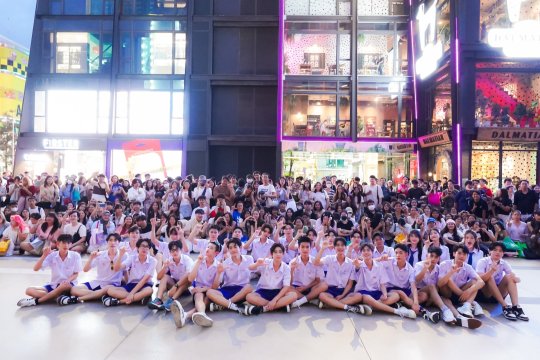
The Love Sick 2024 boys (and three girls) with their audience (Tia51)
Well, for starters, the original Love Sick series is a quintessential classic of Thai BL, arguably the one pivotal work that kick-started the entire TV genre - which in the decade since has developed into an industry worth multi-millions and recognized as a major cultural export. It still holds a place close to many long-time fans' hearts, and BL, like other phenomena of fandom culture, has been known to elicit very enthusiastic emotional responses from followers.
But the scenes witnessed with Love Sick 2024's actors are actually quite reminiscent of those previously seen during the original's release, when BL series didn't yet even exist as a category. Surely, there must be something else underlying this series' - and its actors' - popularity.
Let's take a closer look.
Love Sick's real-life inspiration
In chapter 21 of the original Love Sick novel, Noh, having taken delivery of the music club's new set of drums and overseen band practice for the evening, spends some time sitting around on the stands along the sports pitch next to the F. Building, wondering how he's going to pay for them. It's not long before Earn shows up to rescue him from his financial troubles, but let's pay attention to the location.
The F. Building Noh mentioned is an actual place - F. Hilaire Building at Assumption College (AC) in Bangkok. It is named after Frère (Brother) Hilaire, one of five French missionary teachers of the Catholic Brothers of St. Gabriel who arrived in Siam in 1901.
In the late 19th century, Siam (Thailand's historical name) was rapidly modernizing in response to colonial pressures. American Protestant and French Roman Catholic missionaries played a large role introducing technological and medical advances, and also established some of the first schools in the country as the royal government introduced reforms to formalize the education system. Father Émile August Colombet, the head priest of what was then Assumption Church, founded Assumption College as a school for boys in 1885, and after a decade of growth, the Brothers were invited to help run the school. A convent school for girls, run by the Sisters of St. Paul of Chartres, was established next door soon after.
While the early government schools mostly served the aristocracy, the missionary schools catered more to the general populace, especially the minority ethnic groups who also formed the majority of their congregations. However, while they are remembered today for their legacy of modernization, the missionaries had relatively little success proselytizing, and the large majority of their students remained Buddhist.
Over time, these schools expanded and grew. The St. Gabriel's Foundation now operates over a dozen schools, as well as a university, and Assumption College is regarded as one of the most elite private schools in the country. Its lengthy list of famous alumni includes names from several of Thailand's biggest business families, as well as major political figures, demonstrating its historic stature and the strength of its alumni network. Today, the stereotypical image of its students is of those coming from wealthy or upper middle-class families of Chinese descent, and hefty donations are the norm for families looking to secure placement for their sons.

AC student Keen (Only Boo!) giving a presentation in 2022 on his team's experience joining a NASA-sponsored CanSat (miniature suborbital satellite) competition. It's not like every school has an aerospace program. (Assumption College, via Workpoint Today)
Brother Hilaire, barely 20 when he arrived in Siam, spent his next 67 years dedicated to the school. He learned Thai well enough to write the foundational Thai textbook series Darunsueksa, which remains in use over a century later. Along with Father Colombet, he is memorialized as one of the school's two most celebrated figures.
Today, the building which bears his name overlooks the school's central courtyard, an assembly ground of red brick facing the apse of Assumption Cathedral, an imposing Romanesque Revival structure nestled in Bangkok's old European district along Charoen Krung Road, the city's first modern paved street. Guests headed to the famous Mandarin Oriental Hotel nearby might catch glimpses through the steel palisade fence of boys in their white-and-blue uniforms playing football in the tiny sports pitch - the very place where Noh and Earn had their conversation in the novel. The stands are no longer there, but were present in 2007 when The Love of Siam was filmed at the school. Also appearing in the film, and the site of Noh's classes in the novel, is the 13-storey school building which now towers over the cathedral in order to accommodate its secondary student body of some 2,500 within the limited historic space. (The primary section had been split to a different campus in 1966.)

The F. Hilaire Building clock, and Kao Jirayu as young Tong in the sports pitch, seen in The Love of Siam (Sahamongkolfilm International)
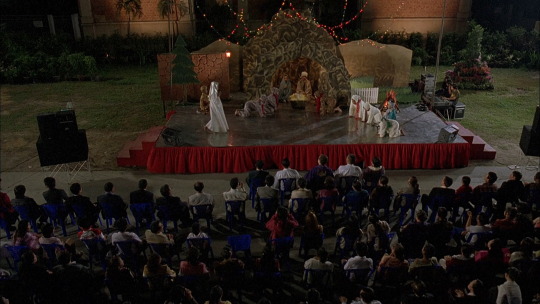
A nativity play right in front of the cathedral would be epic. However, this is artistic licence, as the school's primary section lies elsewhere. This area is now the red brick courtyard; Noh actually mentions in the novel that the school was undergoing a lot of landscaping projects. (Sahamongkolfilm International)
The Love of Siam may have been one of the first few instances where the wider public got to actually see what things looked like inside the school. Although it was only standing in as a location for the fictional St. Nicholas School, there was something about seeing students in their sea of blue uniform shorts that tickled the imagination. Such was the effect that when Love Sick began serializing as a web novel on Dek-D.com a year later, the Thai subtitle, usually translated as The Chaotic Lives of Blue Shorts Guys, undoubtedly helped fuel its popularity.
But what's so special about these blue shorts anyway?
This might come as a surprise to international viewers who've only primarily seen Thailand through its TV series, where they tend to be over-represented, but school uniforms with blue shorts are actually rather uncommon in real life. Let's look back again to Brother Hilaire's time, to find out more about their origins.
A history of the blue shorts
In the early days of formal education, most schools did not have defined uniforms, and AC students wore a varied assortment of costumes according to their ethnic background. The school first introduced a uniform in 1933, consisting of a white standing-collar jacket with metal buttons bearing the school insignia, blue shorts, a white pith helmet, white socks, and black leather shoes (though the helmet, socks and shoes remained optional). This was similar to a form already used by some royally affiliated schools since the 1910s,* though their shorts were navy or black. The reason AC opted for blue shorts is not recorded, though some writers have postulated that it may have been to reflect the common colour of the raj pattern costume, the formal dress of the time.

A class of AC students, with their teachers, in the 1940s. It's unclear whether the shorts were the school's original blue, or khaki green in accordance with the 1939 law. (Assumption Association, via The Cloud)
The first piece of legislation governing school uniforms came out in 1939 under the Fascist-leaning regime of Prime Minister Plaek Pibulsonggram. Male students in government schools were assigned a khaki green military-style uniform to match that of the government's Yuwachon Thahan military youth movement. Some AC students also joined the movement, though those who didn't continued to wear the white uniform, creating an interesting contrast which we'll come back to later. In 1943, at the height of World War II in Southeast Asia, a new law extended the khaki green uniform to all schools, but it's unclear whether it ever took effect as Pibulsonggram was ousted the following year and the Yuwachon movement was dissolved after the war's end.
In 1949, the old regulation was scrapped and replaced with a new one, which codified school uniforms to the almost exact same appearance we see today: for boys, a white shirt, shorts, a belt, socks, and shoes. But the shorts were to be khaki for all schools, except those who requested otherwise to the Ministry of Education. Assumption, together with its sister Gabrielite schools, were among the first to register exemptions and became the only schools with blue shorts for their uniforms for several years.
In 1961, the national regulation was changed again to allow schools to choose between khaki, blue, navy, or black shorts. As time passed, boys' uniforms developed into the convention we see today: black or khaki shorts for government schools, blue or black for private schools. But given their prominence, the image of the all-boys Catholic school has remained one of the strongest associated with the blue shorts uniform.
Not that it mattered much back then, though. In the pre-digital era, people's exposure to different schools was mostly limited to their immediate locality and depictions in the media. While blue-shorts uniforms did feature in some teen movies and sitcoms in the 1990s,† those works didn't really play into the stereotype, and the 1997 financial crisis soon disrupted most media production anyway.
Attracting attention
Then several things happened. The BTS Skytrain opened in 1999, and Bangkok became much smaller overnight - at least for the middle class. Cram schools moved into building spaces in Siam Square left vacant from the recession, and saw an explosion in popularity. School students from all over now flocked to Siam Square in the evenings, and the video classrooms became something of an inter-school melting pot where one could catch sight of all sorts of uniform styles and colours.
And the AC boys, they very much stood out.
It's unclear exactly when things began, but throughout the years, Assumption students had developed a fashion culture of their own. The school is one of a handful that require leather shoes (as opposed to canvas),‡ and its upper-secondary students usually opted for a certain pointy style produced by a couple of old shops on Charoen Krung Road. They would also have their shorts tailor-modified to be very short - typically 15 inches or less, while uniforms coming out of the factory are usually 18 inches at the shortest for high-schooler sizes - and wear them with waists pulled very low. This was despite the rule book stating, like any other school's, that shorts should reach no more than 5 centimetres above the knee. It's actually a common refrain of experiences retold by AC students and alumni that they'd get into trouble for their shorts and shoes whenever the disciplinarian teacher would inspect their uniforms. But it was also part of the challenge, to stay on top of the fashion of their peers and at the same time get away with it.
This fashion only added to the fact that those vivid blue shorts are very visible, like, even from 100 metres away. So, coupled with the stereotype of them being rich kids with likely above-average attractiveness, these AC boys' uniforms easily caught attention, whether they were entering late into a cram school classroom or queuing for the train at the BTS's central interchange at Siam Station during rush hour.

This group strolling down the streets of Siam Square would surely draw plenty of eyes in real life. (Sahamongkolfilm International)
The turn of the 21st century also saw the spread of internet access, and with the early web came the proliferation of online discussion forums, both smaller ones serving specific groups like schools and larger public communities like the youth-oriented Dek-D. Suddenly, it became possible to peak into some of the conversations kids elsewhere were having and share in the knowledge of their hijinks at school. This, in some ways, helped fuel the fantasy of this exclusive boys' world, filled with good-looking guys in revealing shorts who weren't averse to having physical contact with each other.
The online forums also gave birth to web fiction, which soon expanded to include the emerging Y (BL) genre. Naturally, these trends eventually converged to give us plenty of Y fiction set in all-boys schools. But the epitome of these wouldn't arrive until after The Love of Siam hit screens in 2007.
The Love of Siam was probably the first major work in a decade to prominently feature the blue shorts uniform,§ and this time it was actually used to highlight the Catholic boys' school setting, employing AC itself as the location. Though it appeared only in a few short glimpses, they were powerful images that further inspired fascination with the real-life school.
It might be because it's accurate, or because the film has completely coloured viewer's perceptions, but this scene is exactly how one would imagine things to be like in those Catholic boys' schools. (Sahamongkolfilm International)
Then in 2008, Love Sick quietly began serializing on Dek-D's writers' section. The story's premise was simple, but it so effectively tapped into this collective fascination and quickly rose up the site's readership charts. Its popularity came no doubt thanks to author Indrytime's extremely lively and enjoyable writing of Noh, who narrates the story throughout. But a large part of the appeal is also attributable to the lifelike portrayal of his school life, with plenty of references to actual locations both within the school and outside - including the convent school next door and the numerous shops of Siam Square. The novel also name-dropped some of the school's actual teachers who, in Catholic school fashion, are addressed as Miss and Master, and Noh even mentions specific happenings at AC, like the new belt buckles that had been added to the school uniform for younger students that year. The only thing not mentioned was the name of the school, which was intentionally left blank. So close did the story feel to real life that the author had to emphasize its fictional nature when people started speculating about the real identities of Punn‖ and Noh and tried to identify them with actual AC students.
But the most significant reference to real life in Love Sick by far must be its descriptions of what is clearly meant to be the Jaturamitr football competition - a biennial event between Thailand's four oldest boys' schools: Assumption College, its Protestant counterpart Bangkok Christian College (BCC), and the royally founded government schools Suankularb Wittayalai (SK) and Debsirin (DS). The tradition is a HUGE part of school life at these four schools, which pretty much share this culture of intense collective institutional pride.
These boys and their ball game
It's kind of hard to explain all that the competition entails, but the football is just a small part of it. This YouTube video looking at the BCC side makes for a nice intro.¶ There are parades, mascots, Thai-style cheerleading (featuring not acrobatics, but synchronized arm movements), and most notably, the spectacular card stunt displays, which involve the entire student body from the lower-secondary years. The students will spend months practising to perfect their card flips, under the direction of the cheering president. Sounds familiar? That's Earn's position in Love Sick.
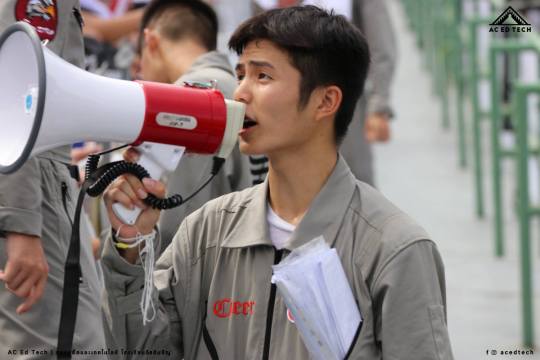
Fourwheels (Oxygen, Nitiman, La Pluie), wearing the cheering crew overalls that Noh dreams of, addressing the AC crowd in 2017 (AC Ed Tech)

Beam Boonyakorn (Make It Right) as AC's eagle mascot, though it's often teased for looking more like a chicken, also in 2017 (TTaewTaew Twitter)
The card stunt tradition actually originated at AC in 1942, from the aforementioned contrast between the military youth and regular uniforms. A teacher came up with the idea of having the differently dressed students arrange to form the school initials on the stands. This eventually developed into the elaborate displays done today, which use coloured card booklets to create pixels that together form a detailed aggregate image. Crowds of 1,250 from each school, seated opposite the paying audience, are needed to perform these.
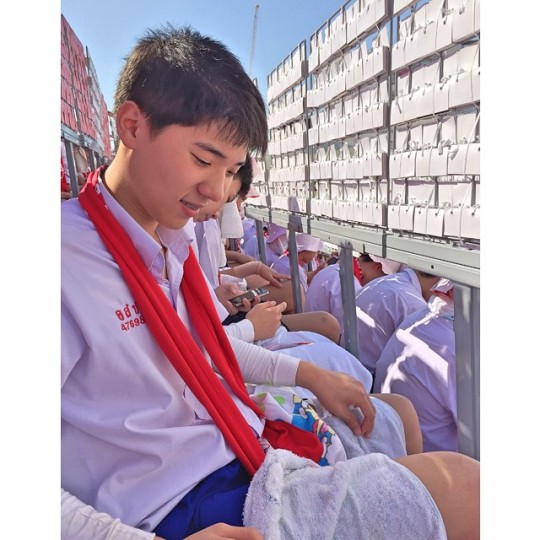
Oat Tharathorn (Fourever You) in the card-stunt-performing audience in 2014; note the plates of colour card booklets set on the racks in front of them. (oattrt Instagram)

Such plates appeared in Love Sick 2024's episode 4 behind-the-scenes clip, but didn't show up in the actual episode. They later appeared in episode 5. (Tia51)
Regular fixtures among these displays include school logos, the royal family, and sponsors. There are also have these coordinated sequences with portraits of students and alumni greeting the crowd, which may feature some familiar faces.

A sponsor ad for Est gives way to AC student Chimon greeting the audience in 2017. (AC Ed Tech)
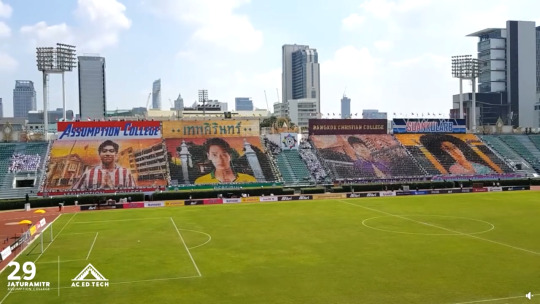
Alumni PP Krit (AC), Ice Natara (DS), Nonkul (BCC), and Sky Wongravee (SK) welcoming the audience, 2019 (AC Ed Tech)
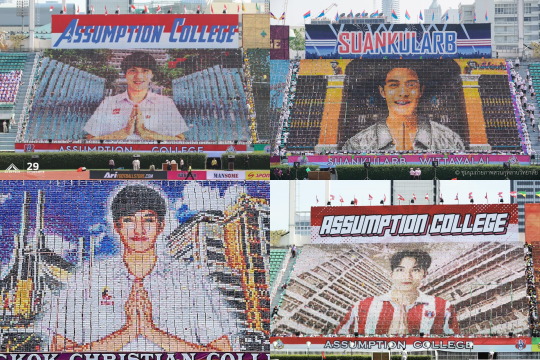
GMMTV's Marc (AC) and Ford (SK) from the same sequence in 2019; Inn (BCC) from before 2014; AC alum Net Siraphop in 2023 (AC Ed Tech; Suankularb Photo Club; inpitar Instagram)
This attention to popular students didn't exist during novel Noh's time, though. Back then, few people followed the event apart from the schools' students and alumni, and football people scouting for young talent. But the 2010s' "cute boy" craze brought a sharp rise in attention from the sao-Y and cute-boy-following crowds, who flocked to the matches, some equipped with huge telephoto lenses to capture not the football action but cute guys in the audience.

BCC alumnus Inn Sarin photographed in the audience in 2014. Photos of him from the event were virally shared and boosted his following and "cute boy" stature. (inpitar Instagram)

BCC cheerleaders Winny Thanawin (2017) and Ping Krittanun (2019) (BCC Jaturamitr)
The origination of Thai BL
In some ways, the Love Sick novel helped lay the foundations for the phenomenon. It gave readers this imaginary connection to the school, which drove interest in seeing what its real-life students shared on social media, especially as Instagram exploded in popularity around 2012. And of course, attractive boys in revealing uniform shorts was already a winning combination in itself (and the fashion soon spread to other schools).
So it's appropriately fitting that things would come full circle with the 2013 announcement of Love Sick The Series, which generated huge amounts of engagement as fans recalled their impressions of the characters and shared pictures of real-life AC students whom they saw as the perfect Punn and Noh.
As it turned out, recent AC graduate White was cast as Punn, and several other AC boys were also chosen for the many supporting characters. Fans readily took to following these budding actors from the moment they were announced, gathering to meet them after acting classes and supporting them through to the last post-series events. It was a revelation in how dedicated such a fandom could be, without seeing even a second of these actors' work.
For the production, though, it could hardly be expected that explicit reference to the real-life school would be allowed, so they named the school Friday College in the series. (Which kind of bugs me. Couldn't they have at least come up with a vaguely Catholic-sounding name? Anyway, they developed it into a brand and it's stuck now.) They did model the school emblem and uniform exactly after AC's (in its 2008 form, before the new belt buckle), and the same uniform was featured in Thank God It's Friday, a 2019 spin-off set in the same universe. However, the school emblem was redesigned for the 2024 Love Sick remake, maybe because the resemblance now felt too close for comfort. (Another detail that bugs me is how the 2014 series had four-digit student IDs, while the 2024 has six. Most real-life schools have five digits!)
While it would have been a dream come true to see the actual original locations in the series adaptation (even if unnamed), this was not to happen. In fact, unlike its sister school Assumption College Thonburi, which served as the location for Hormones and numerous other works, AC seems to no longer be keen on allowing access as a filming location, and hasn't been spotted in anything since The Love of Siam.
Anyway, Love Sick's broadcast was a turning point in several ways. Of course, it most importantly kickstarted the Thai BL industry,** but this also led to a shift in Y culture where shippers turned their focus from real people to actor pairs from series. "Cute boys" from social media were now regularly tapped to join the many budding modelling agencies, who would try to push them as actors and influencers, and AC students attracted particular attention. Make It Right (2016)'s Peak, Ohm and Beam, for example, were all scouted from the school.

AC students Peak, Ohm and Beam, taken by a fan account in 2016. (allaboutpeak Twitter)
The boys made use of their newfound cult. Popular AC students were tapped to promote the school's annual Christmas Fair, which drew an influx of visitors from their followers, who happily contributed to their fundraising efforts. This was much changed from Noh's time in the novel, when the fair was still pretty much an internal event for students and their immediate friends and family.
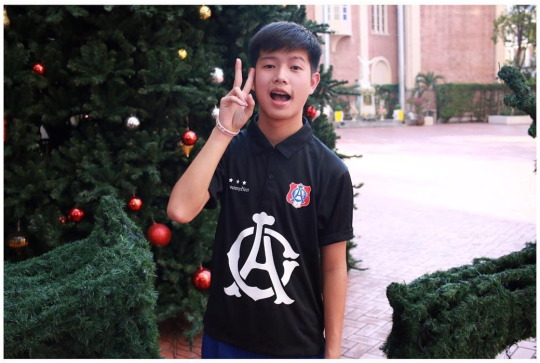
Turbo (Love Stage!!) promoting merch for AC's 2015 Christmas Fair (turbotb Instagram)
However, this trend, as with the cute boy craze itself, seems to have largely petered out, especially as life was disrupted by the COVID pandemic and the 2020 protests brought about sharp changes in ideology among young people. Another victim of this has been the Jaturamitr competition, which was postponed for two years before taking place again in 2023.†† But it then became the topic of a huge online drama over the compulsory nature of attendance for the card stunt performances (which not everyone willingly enjoyed), and the negative public attention soured the experience for a lot of the students.
These new concerns seem to have influenced Love Sick's 2024 remake. In the novel, during preparation for the football competition, Noh talks about how hard the marching band was practising, and how he and the band leaders felt the need to push them to perfection, in order to uphold the school's reputation. There's a clear institutional pride in the way he says, "I'm sure the young ones understand. (Or if they don't now, they will in a few years.)"
This stands in sharp contrast to Earn's stance in Love Sick 2024, where he says in episode 4, "If the formation fails, the school’s reputation will just take a hit. But the school doesn’t have feelings, does it? It is they (the young ones) who have feelings."
We'll find out in a couple of hours how else they're updating the depiction of the competition, which was one of the highlight scenes in the novel thanks to how detailed it was with insider info of the behind-the-scenes workings at the Suphachalasai National Stadium in real life. It's an unfortunate fact, though, that it's near impossible that any TV production with a normal budget would even come close to the spectacle of the actual event, with its crowds in the tens of thousands. But let's see how creative the production crew can be.
After all, it's the emotional threads that make the real highlight of the story, isn't it?
Footnotes
* These schools had been set up after the English public school model by King Vajiravudh, who himself was educated in England. Vajiravudh College still uses it as its ceremonial uniform.
† One of these was I Miss You 2 (1996), which was filmed at Montfort College in Chiang Mai, another Gabrielite school. Incidentally, The Love of Siam director Madeaw Chookiat was a student there and became an extra in the film, an experience which inspired him to go into filmmaking. He would later base the Nay-Beam segment of Home (2012, one of the most significant mainstream proto-BL works) at the school.
‡ Most other schools allow both, and their students usually prefer canvas shoes. Nanyang, with its iconic green soles, has long been the most popular brand.
§ Actually there's at least Yong Songyos's Dorm (2006), set at his alma mater Assumption College Sriracha, but it's a horror focusing more on the boarding-school aspect. Yong also created a short film dedicated to the school in 2015, starring four Hormones Next Gen actors (no English subs, but there are hardcoded Thai captions that maybe a tool can translate).
‖ Sorry, but I just can't accept the spelling Phun, as it's plain incorrect. The /p/ and /ph/ are supposed to represent different sounds in Thai, but most Thai people don't understand the system as it's not taught in schools.
¶ As an expat, the video creator misses the meanings of some of the things that happen in the video. The yellow chicken is a reference to a Facebook satirist who's said to bring bad luck to sports teams, while the no-banana sign is a response to the angry chant the BCC side was yelling. It's an expletive that rhymes with the word for banana in Thai.
** Isn't it ironic that a genre revolving around a topic so controversial with the Church should be inspired by a Catholic school? But then, as director Madeaw demonstrated in The Love of Siam, religious conflict has always played an important role in driving social issues, while in the case of Love Sick, it's not actually relevant at all.
†† Yet another victim is the Chula-Thammasat Traditional Football Match, a competition between Thailand's two oldest universities which features similar elements of parades, cheerleading and card stunts. It hasn't been properly held since 2020, and when a substitute event was held in 2024, a huge online drama erupted over the student body's decision to alter certain elements.
119 notes
·
View notes
Text
A kind soul on Reddit made a relationship chart for Love Sick.

Thank God.
76 notes
·
View notes
Text
Heart’s Sign Language Translated
Thank you to @virtualtadpole for sending along the following Reddit post they made that compiles videos of different Modern Thai Sign Language signs and applies them to Heart’s lines in Moonlight Chicken!!
Everyone who has enjoyed Moonlight Chicken should watch this in my opinion. Learn some sign language while you’re at it!!
287 notes
·
View notes